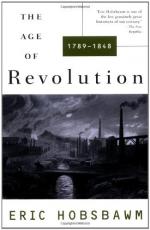
|
| Name: _________________________ | Period: ___________________ |
This test consists of 15 multiple choice questions and 5 short answer questions.
Multiple Choice Questions
1. Who does Hobsbawm say rose to prominence financing the wars?
(a) The Rockefellers.
(b) The Jews.
(c) The Barings and Rothschilds.
(d) Swiss.
2. Which of the revolutions that took place in the first wave of revolutions after the French Revolution was NOT suppressed?
(a) Spain.
(b) Ireland.
(c) Turkey.
(d) Greece.
3. Europe was ruled by Britain, France, Austria, Prussia and which nation?
(a) Greece.
(b) Romania.
(c) Russia.
(d) China.
4. Where did Britain expand its relationships after the French Revolution?
(a) With its colonies.
(b) With France and Spain.
(c) With Russia and Prussia.
(d) With China and Indonesia.
5. What trend was Hobsbawm looking for in revolts and revolutions?
(a) Modernism.
(b) Indigenosity.
(c) Nationalism.
(d) Local traditions.
6. Who was represented by the "Third Estate" in France?
(a) The merchants.
(b) The nobles.
(c) The bourgeoisie.
(d) The common people.
7. What relationship had begun to dominate between landowners and farmers in England in the late 1700s?
(a) Lord and vassal.
(b) Landlord and tenant-farmer.
(c) Frontiersmen were opening new lands in Europe.
(d) Communal ownership.
8. France was opposed by which of these in the Napoleonic Wars?
(a) Russia, Prussia and Austria.
(b) Austria and Prussia.
(c) All of Europe and Britain.
(d) Britain and Russia.
9. What set the stage for the French Revolution, in Hobsbawm's account?
(a) France's war with Austria.
(b) France's war with Russia.
(c) France's war with Britain.
(d) France's war with Prussia.
10. Which nation ruled most of Asia in the late 1700s?
(a) Australia.
(b) India.
(c) Russia.
(d) China.
11. How did the concept of nationalism spread through Europe?
(a) From east to west.
(b) From west to east.
(c) From France outward in every direction.
(d) From north to south.
12. Which nation led the others in industrialization?
(a) Britain.
(b) Russia.
(c) Prussia.
(d) France.
13. What cause did Russian and Britain support together after the French Revolution?
(a) The independence of Turkey.
(b) The independence of Greece.
(c) The independence of Poland.
(d) The independence of Finland.
14. Which areas were best connected, according to Hobsbawm?
(a) The seacoasts.
(b) The mountains.
(c) The islands.
(d) The farm country.
15. What was abolished in the wake of Napoleon's victories?
(a) Colonialism.
(b) Feudalism.
(c) Aristocracy.
(d) Monarchy.
Short Answer Questions
1. What product does Hobsbawm say was the catalyst for the Industrial Revolution?
2. Where were spinning and weaving performed prior to the Industrial Revolution?
3. Where does Hobsbawm see a culture combining nationalism with the revolutionary spirit of the French Revolution?
4. In what fields were cultural developments being made fastest in the late 1700s, according to Hobsbawm?
5. What idea does Hobsbawm say was just being developed after the turning point of 1830?
|
This section contains 415 words (approx. 2 pages at 300 words per page) |

|




